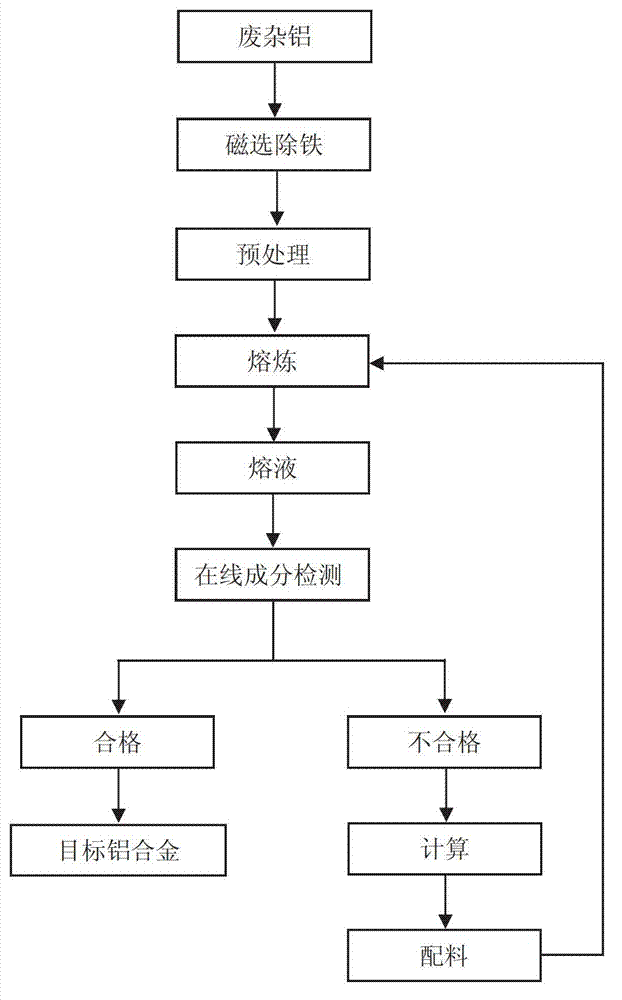Method for regenerating aluminum alloy with target ingredient from scrap aluminum
A technology of target components, waste miscellaneous aluminum, applied in the direction of improving process efficiency, etc., can solve problems such as no pollution-free pretreatment, low recovery rate, environmental pollution, etc., achieve significant economic and environmental benefits, and be easy to industrialize. Production, the effect of eliminating environmental pollution
- Summary
- Abstract
- Description
- Claims
- Application Information
AI Technical Summary
Problems solved by technology
Method used
Image
Examples
Embodiment 1
[0049] The recycled scrap aluminum is made into standard 3104 aluminum alloy for pop cans.
[0050] (1) Magnetic separation and iron removal: Magnetic separation removes ferromagnetic materials in waste aluminum;
[0051] (2) Pretreatment: adopt the low-temperature distillation process with a drying temperature of 60°C for 3.0h and 120°C for 3.0h to remove moisture and grease in waste aluminum; use oxygen partial pressure ≦ 10% for organic matter on the surface of waste aluminum at a temperature of Process vibration removal at 600°C for 15 minutes;
[0052] (3) Melting: Swirl suction type submerged melting is adopted, and the melting temperature is controlled at 700°C;
[0053] (4) On-line component detection: take a small amount of fully stirred aluminum liquid, and use a direct reading spectrometer ARL3460 for component detection. Table 2 shows the composition of 3104 aluminum alloy specified in "GB / T3190-2008 Chemical Composition of Deformed Aluminum and Aluminum Alloy", ...
Embodiment 2
[0081] The recycled scrap aluminum is made into standard 6061 aluminum alloy for automobiles.
[0082] (1) Magnetic separation and iron removal: Magnetic separation removes ferromagnetic materials in waste aluminum;
[0083] (2) Pretreatment: adopt the low-temperature distillation process with a drying temperature of 90°C for 2.0 hours and a drying time of 180°C for 2.0 hours to remove moisture and grease in waste aluminum; use oxygen partial pressure ≦ 10% for organic matter on the surface of waste aluminum and a temperature of Process vibration removal at 550°C for 30 minutes;
[0084] (3) Melting: Press-in type submerged melting is adopted, and the melting temperature is controlled at 750°C;
[0085] (4) On-line component detection: take a small amount of fully stirred aluminum liquid, and use a direct reading spectrometer ARL3460 for component detection. Table 5 shows the composition of the 6061 aluminum alloy stipulated in "GB / T3190-2008 Chemical Composition of Deformed...
Embodiment 3
[0118] The recycled scrap aluminum is made into an aluminum alloy with the composition of cast aluminum ZL105 (ZAlSi5Cu1Mg).
[0119] (1) Magnetic separation and iron removal: Magnetic separation removes ferromagnetic materials in waste aluminum;
[0120] (2) Pretreatment: take drying temperature 100 ℃, time 1.5h and 200 ℃, 1.5h low-temperature distillation process to remove moisture and grease in waste aluminum; use oxygen partial pressure ≦ 10% for organic matter on the surface of waste aluminum, and the temperature is Process vibration removal at 500°C for 45 minutes;
[0121] (3) Melting: vortex type submerged melting is adopted, and the melting temperature is controlled at 800°C;
[0122] (4) On-line component detection: take a small amount of fully stirred aluminum liquid, and use a direct reading spectrometer ARL3460 for component detection. Table 8 shows the composition of the ZAlSi5Cu1Mg aluminum alloy specified in "GB / T1173-1995 Casting Aluminum Alloy", the composi...
PUM
 Login to View More
Login to View More Abstract
Description
Claims
Application Information
 Login to View More
Login to View More - R&D
- Intellectual Property
- Life Sciences
- Materials
- Tech Scout
- Unparalleled Data Quality
- Higher Quality Content
- 60% Fewer Hallucinations
Browse by: Latest US Patents, China's latest patents, Technical Efficacy Thesaurus, Application Domain, Technology Topic, Popular Technical Reports.
© 2025 PatSnap. All rights reserved.Legal|Privacy policy|Modern Slavery Act Transparency Statement|Sitemap|About US| Contact US: help@patsnap.com



